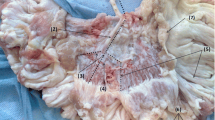Summary
Strips of two canine vessels with different patterns of sympathetic innervation were used: the mesenteric artery which has an adventitio-medial plexus and the saphenous vein in which nerve terminals are distributed throughout the media.
The pD2 of (−)-adrenaline for α-and β-adrenoceptors was determined for both vessels (in the presence of 0.5 μM propranolol and 7 μM phentolamine, respectively; in the latter case the strips were contracted by 0.28 μM prostaglandin F2α) and found to be very similar: 6.96 and 7.01 in the saphenous vein and 6.77 and 6.91 in the mesenteric artery, respectively. The similarity of pD2 for adrenaline acting on α-and β-adrenoceptors in both preparations allowed us to compare the effect of inhibition of neuronal uptake by 12 μM cocaine with that of inhibition of COMT by 50 μM dihydroxy-2-methyl propiophenone (U-0521) on: a) the potency of adrenaline (noradrenaline was used in the saphenous vein only) acting on α-and β-adrenoceptors and b) the time required by the strips to recover 50% in oil (t 50) after contractions or relaxations caused by 0.23 μM adrenaline. In the saphenous vein cocaine increased the potency of both adrenaline and noradrenaline for α-effects more than for β-effects (2.8 times vs. no increase for adrenaline; 7.1 vs. 1.9 times for noradrenaline) and U-0521 increased the potency of both adrenaline and noradrenaline for β-effects more than for α-effects (4.1 vs. 2.6 times for adrenaline; 1.8 times vs. no increase for noradrenaline); regarding the termination of action of adrenaline, cocaine prolonged the t 50 1.6 times after contraction and did not change it after relaxation, whereas U-0521 prolonged the t 50 6.9 times after relaxation and only 1.8 times after contraction.
In the mesenteric artery only sensitivity experiments were done. Cocaine increased the potency of adrenaline by a factor of 2.1 for the α-effects while there was no influence on its potency with regard to its β-effects, and U-0521 increased the potency of adrenaline for the β-effects more than for α-effects (3.9 vs. 1.8 times, respectively).
These results show that there are two different biophases for sympathomimetic agonists in the vasculature: one for α-adrenoceptors which is more under the influence of the neuronal uptake and one for β-adrenoceptors which is more under the influence of COMT activity. We conclude that α-adrenoceptors are situated close to the nerve endings and β-adrenoceptors close to COMT sites. Since these results do not differ qualitatively in two vessels with different patterns of innervation, we conclude that this asymmetry in the distribution of α-and β-adrenoceptors may be due to either an uneven distribution of cells with only one type of receptors each or due to an uneven distribution of receptors on the same cell.
Similar content being viewed by others
References
Belfrage E, Rosell S (1976) The role of neuronal uptake at α-and β-adrenoceptor sites in subcutaneous adipose tissue. Naunyn-Schmiedeberg's Arch Pharmacol 299:9–15
Bevan JA, Su C (1973) Sympathetic mechanisms in blood vessels: nerve and muscle relationships. Ann Rev Pharmacol 13:269–285
Bevan JA, Török J (1970) Movement of norepinephrine through the media of rabbit aorta. Circ Res 34:325–331
Bevan JA, Verity MA (1967) Sympathetic nerve-free vascular muscle. J Pharmacol Exp Ther 157:117–124
Burnstock G, Costa M (1975) Adrenergic neurons. Chapman and Hall, London
Coimbra A, Ribeiro-Silva A, Osswald W (1974) Fine structural and autoradiographic study of the adrenergic innervation of the dog lateral saphenous vein. Blood Vessels 11:128–144
Guimarães S (1975) Further study of adrenoceptors of the saphenous vein of the dog: influence of factors which interfere with the concentrations of agonists at the receptor level. Eur J Pharmacol 34:9–19
Guimarães S, Osswald W (1969) Adrenergic receptors in the vein of the dog. Eur J Pharmacol 5:133–140
Guimarães S, Paiva MQ (1977) Differential influence of block of catechol-O-methyl transferase (COMT) activity and neuronal uptake on α-and β-adrenergic effects. J Pharm Pharmacol 29:502–503
Guimarães S, Azevedo I, Cardoso W, Oliveira MC (1975) Relation between the amount of smooth muscle of venous tissue and the degree of supersensitivity to isoprenaline caused by inhibition of catechol-O-methyl transferase. Naunyn-Schmiedeberg's Arch Pharmacol 286:401–412
Henseling M (1980) Distribution and metabolism of 3H-noradrenaline entering the rabbit aorta either through the adventitia or through the intima. Naunyn-Schmiedeberg's Arch Pharmacol 311:R61
Johansson B, Ljung B, Malmfors T, Olson L (1970) Prejunctional supersensitivity in the rat portal vein as related to its pattern of innervation. Acta Physiol Scand Suppl 349:5–16
Kalsner S, Nickerson M (1968) A method for the study of mechanisms of drug disposition in smooth muscle. Can J Physiol Pharmacol 46:719–730
Langer SZ, Trendelenburg U (1969) The effect of a saturable uptake mechanism on the slopes of dose-response curves for sympathomimetic amines and on the shifts of dose-response curves produced by a competitive antagonist. J Pharmacol Exp Ther 167:117–142
Ljung B (1970) Nervous and myogenic mechanisms in the control of a vascular neuroeffector system. Acta Physiol Scand Suppl 349:33–68
Paiva MQ, Guimarães S (1978) Comparative study of the uptake and metabolism of noradrenaline and adrenaline by the isolated saphenous vein of the dog. Naunyn-Schmiedeberg's Arch Pharmacol 303:221–228
Paiva MQ, Guimarães S (1980) The oil immersion technique for studying the disposition of drugs inducing relaxation; influence of U-0521 and hydrocortisone on the disposition of isoprenaline. J Pharm Pharmacol 32:868–869
Rosell S, Belfrage E (1975) Adrenergic receptors in adipose tissue and their relation to adrenergic innervation. Nature 253:738–739
Trendelenburg U (1972) Factors influencing the concentration of catecholamines at the receptors. Handb Exp Pharmakol 33:726–761
Author information
Authors and Affiliations
Rights and permissions
About this article
Cite this article
Guimarães, S., Paiva, M.Q. Two distinct adrenoceptor-biophases in the vasculature: One for α-and the other for β-agonists. Naunyn-Schmiedeberg's Arch. Pharmacol. 316, 195–199 (1981). https://doi.org/10.1007/BF00505649
Received:
Accepted:
Issue Date:
DOI: https://doi.org/10.1007/BF00505649




